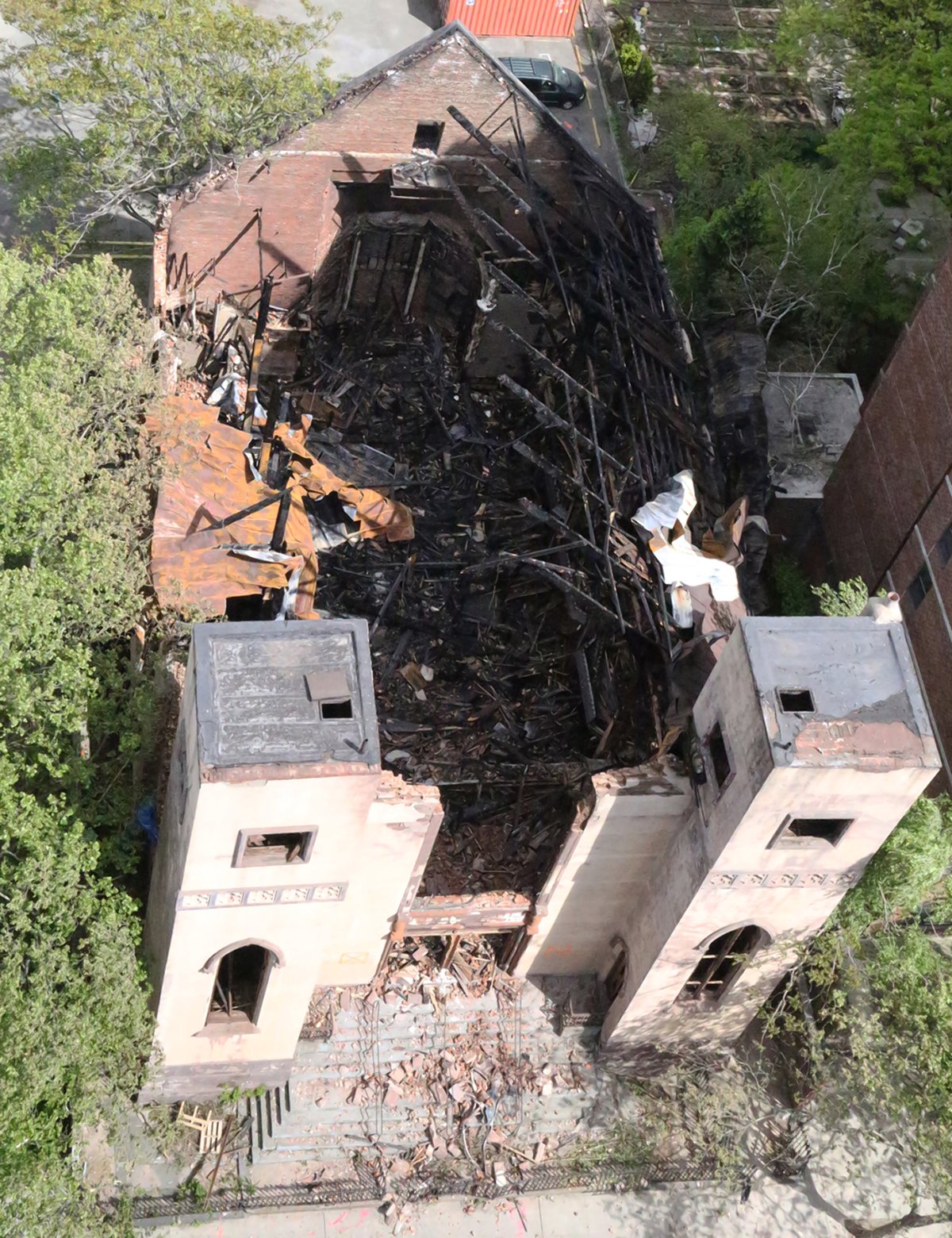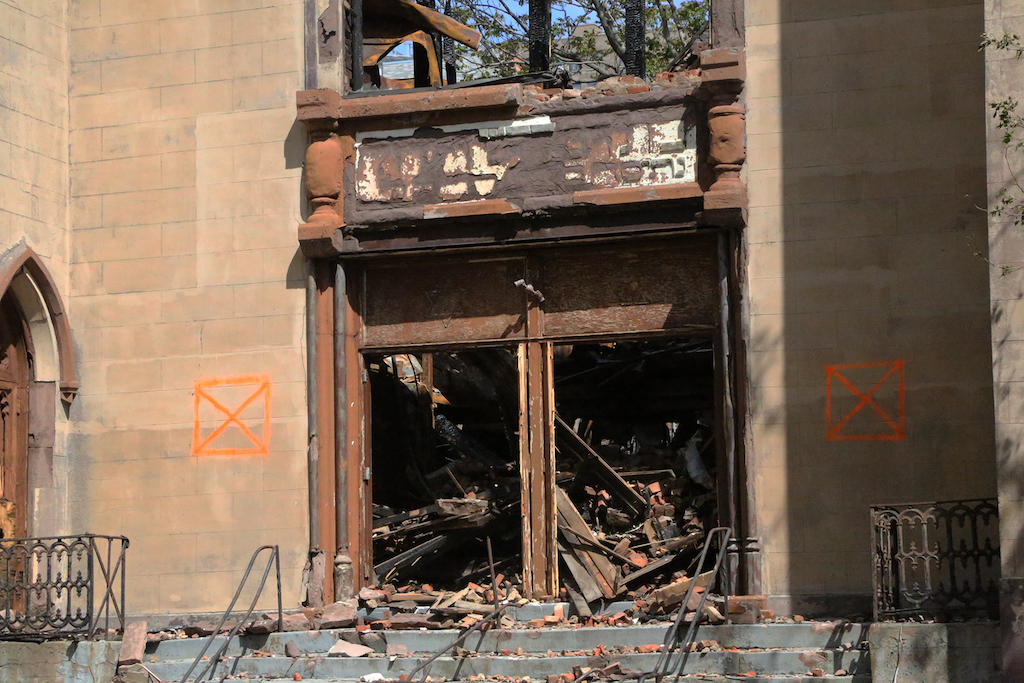BY BILL WEINBERG | The fate of the forlorn remains of the landmarked Beth HaMidrash HaGadol synagogue on Norfolk St. — gutted by fire on May 14 — is clearly an agonizing question for the Lower East Side’s Jewish community.
On June 20, the Community Board 3 Landmarks Committee, meeting at the Evelyn & Louis A. Green housing residence off Cooper Square, passed a resolution to protect as much as can be saved of the original structure after public safety is taken into account. The vote followed much testimony, some of it openly anguished, on the historical significance of the building and the options for its future.

Arguing for demolition of the remaining structure, ostensibly on safety grounds, was Rabbi Mendel Greenbaum, leader of the Beth HaMidrash HaGadol congregation, which has been inactive for several years. He was backed up by a study from the Howard L. Zimmerman architectural firm, which has filed a “proposal for demolition” with the Department of Buildings.
The summary of the demolition proposal made available to C.B. 3 and the city Landmarks Preservation Commission does broach “Potential salvage of Building components or relics found in safe or repairable condition as determined by Engineer.” And Greenbaum accepted this in principle.
However, an accompanying map shows the street-front facade with its twin steeples and almost all the rest of the building marked as “beyond repair.” This category excludes only two walls — on the building’s south side and in its rear to the east. These areas are dubbed “potentially beyond repair.”
Urging preservation of the building to the extent possible were former congregants, as well as local historians, activists and academics.
The C.B. 3 Landmarks Committee resolution noted the testimony for preservation. It stated that “the Synagogue is beloved by the community, despite its poor condition in recent years, as confirmed by public testimony…strongly opposing complete demolition… .”
The resolution said the committee “approves the application for demolition, but urges the Landmarks Preservation Commission, Department of Buildings, the Chinese American Planning Council and the Synagogue to work together with the structural engineers to determine which elements of the Synagogue can be retained safely and that those elements be incorporated into any new building on the lot.”
The Chinese American Planning Council runs the Hong Ning senior housing complex next door to the synagogue. It owns land abutting the synagogue on the south and east, and had options for use of air rights from the historic building. The Planning Council was represented at the meeting by former City Councilmember Alan Gerson, who said the organization would “respect the preservationist desires expressed at this meeting.”
In her remarks, Dr. Elissa Sampson, a longtime neighborhood resident and a Jewish studies scholar at Cornell University, captured the feeling of preservationists’ frustration at the meeting.
“While we don’t know fully what can reasonably be saved now, it is eminently clear that with some real effort, the building could have been saved before the fire,” she testified. “Instead, each year we watched how bidding [for the property] went higher, even as the building continued to deteriorate further to the point of dereliction.”
She recalled that in 2012, four years after it was abandoned, the synagogue filed a hardship application with the Landmarks Preservation Commission, seeking permission to demolish the structure.
This was acknowledged by Greenbaum, who said the application had been withdrawn due to a “change of heart.”
The rabbi, however, denied charges that the charity that actually owns the property is controlled by his own
family. This is the Beth HaMedrash HaGadol of New York Restoration Inc., to which the building was officially turned over by the congregation in 2009, the year after the synagogue closed its doors for the last time.
It was also noted at the meeting that the building had suffered two fires before the one of May 14. One, exactly a week earlier, was quickly extinguished by firefighters. Another, in 2001, caused significant damage to the house of worship’s interior. A local 14-year-old has been charged with arson in the most recent and devastating fire.
At least one speaker at the June 20 meeting openly expressed suspicion that the building’s owners were complicit in the arson and hoping to cash in on the real estate, which is presumably far more valuable vacant.
At the meeting, Rabbi Greenbaum admitted that air rights above the landmarked building were worth an estimated $12 million before the fire, whereas the site without landmark protection could fetch $18 million.
Numerous reports indicated that the synagogue’s owners had been in talks with the Gotham Organization — developers of the Gotham West luxury complex on 11th Ave. in Midtown.
When asked by this reporter if the Gotham Organization idea has now been officially dropped, Greenbaum’s consultant Thomas McMahon replied by e-mail: “Nothing official. The idea and conversation continues to find a way [sic] to develop the property in a way that makes sense. Gotham was one of the respondents to a RFP [request for proposals] issued by the CaPC [Chinese American Planning Council].”
But most at the meeting seemed to accept the summation of Joyce Mendelsohn, author of “The Lower East Side Remembered and Revisited,” that the synagogue had suffered “demolition by neglect.”
When word of the fire first broke, the Lower East Side was abuzz with speculation. The two going theories were that it had been an anti-Semitic hate crime or landlord arson — “Jewish lightning,” in the ugly popular phrase. Neither of these seem to have been the case, but this hardly lessens the loss to the community.
Beth HaMidrash HaGadol, at 60 Norfolk St., was the oldest Russian Jewish synagogue in the United States. It was established in 1885, moving into a former Baptist church built in 1850 — some of whose parishioners later founded the famous interdenominational Riverside Church in Morningside Heights. An early leader was the revered Lithuanian-born Rabbi Jacob Joseph, who in 1888 was elected the first — and only — “Chief Rabbi” of New York by the city’s Orthodox congregations.
For 50 years until his death in 2003, Beth HaMidrash HaGadol was led by Rabbi Ephraim Oshry, a Holocaust survivor and notable historian, who wrote “The Annihilation of Lithuanian Jewry.” Rabbi Greenbaum is his son-in-law.
The building was landmarked in 1967, but finally abandoned by the dwindling congregation in 2008.
Of potential concern to scholars is the library in the synagogue’s basement, which apparently suffered no serious damage in the fire. When asked about the library’s contents, Greenbaum replied by e-mail: “There were some older Talmud volumes, which we put in safe place. And in the basement basically were left prayer books and chumashim” — books of the Torah printed individually in bound volumes rather than traditional scrolls.


















